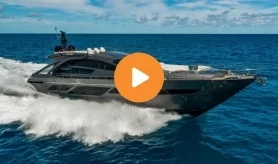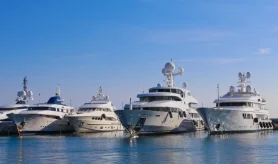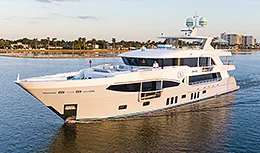- Alaskan Yachts
- Azimut Yachts
- Back Cove Yachts
- Beneteau Yachts
- Benetti Superyachts
- Bertram Yachts
- Boston Whaler
- Broward Yachts
- Buddy Davis Sportfish
- Burger Yachts
- Cabo Yachts
- Catamarans
- Carver Motoryachts
- Center Console
- Chris-Craft Yachts
- Cruisers Yachts
- DeFever Trawlers
- Dufour Sailboats
- Fairline Yachts
- Feadship Yachts
- Ferretti Yachts
- Formula Yachts
- Fountaine Pajot Cats
- Grady-White
- Grand Banks Trawlers
- Hargrave Yachts
- Hatteras Yachts
- Hinckley Picnic Boats
- Horizon Yachts
- Hydra-Sports
- Intrepid Boats
- Jarrett Bay Sportfish
- Jeanneau Yachts
- Kadey-Krogen Trawlers
- Lazzara Yachts
- Lekker Boats
- Luhrs Sportfish
- Marlow Yachts
- Maritimo Yachts
- Marquis Yachts
- Mazu Yachts
- McKinna Motoryachts
- Meridian Yachts
- Midnight Express
- MJM Yachts
- Mochi Craft
- Neptunus Motoryachts
- Nordhavn Trawlers
- Nordic Tugs
- Numarine Yachts
- Ocean Alexander Yachts
- Ocean King
- Offshore Yachts
- Outer Reef
- Oyster Sailing Yachts
- Pacific Mariner Yachts
- Palmer Johnson Yachts
Albin 40 North Sea Cutter 2005
![]()

Source: Capt. Bill Pike, Power & Motoryacht Magazine
What a gorgeous, New England day it was and what a pretty blue-hulled, China-built 40-footer docked there behind Eastern Yacht Sales, Albin Marine’s dealership in Hingham, Massachusetts. For a moment I stopped to study her profile from afar—boxy perhaps, particularly minus the bimini top most owners will opt for, but muscularly built and undeniably salty-looking. Thick, welded-stainless steel rails and solid lifelines gleamed in the sun.
“Ahoy there,” grinned Eastern’s Michael Brockman, a leprechaun-like fellow who stepped through the doorway on the port side and headed aft. “I hope you’re not lookin’ for wicked sea conditions today—we’re fresh out.”
“No problem,” I replied. Bad weather’s the cat’s meow for heroic, high-seas wringouts, but I’ve had my fill of heroics over the years. Flat calm’s good for the soul sometimes, especially when you’re in the mood to just kick back, sip a cold Poland Spring, and cruuuuuise.
Shortly after Brockman had given me a hand up, I made a quick circuit of the 40’s weather deck and formed two impressions. First, initial transverse stability was excellent, a virtue I’d attribute to a semidisplacement hull form with wide chine flats and plenty of heft (dry weight: 25,000 pounds) as well as a deep, trawlerish draft of four feet. Hoofing it from one side of the boat to the other produced little heel; the 40 simply held steady, as immovable as a parking lot. And second, whether it was the beefy, solidly latched hatch on the anchor locker, the solid thunk of the deck underfoot, or the heavy, molded-fiberglass sliding doors on either side of the superstructure, every detail of construction seemed to say just one thing: Here was a hearty, thick-skinned fireplug of a boat, up for dang near anything.
I cranked the mains at the lower station. Once our 370-hp Yanmars had already chortled a few minutes by way of a warm-up, I went topside to the flying bridge, clutched both engines in and out of gear to make sure all was mechanically well (the split-type Morse mechanical engine controls were extremely stiff but workable nevertheless), and then asked Brockman to toss off our lines. As he jumped aboard, I eased the test boat out of her slip and headed toward Hingham Bay.
The 40’s a practical boat. Visibility, whether I was seated or standing, was excellent all the way around, the helm chair was cushy, the instrumentation easy to keep tabs on, and the ambiance on the bridge was generally serene and peaceful…for a while. Then, quite quickly, Brockman and I were involuntarily thrust into an impromptu little seafaring drama that brought us limping back to the dock at idle speed with oil-pressure and water-temperature gauges dangerously pegged.
We rectified the issue immediately, at least for a couple of middle-agers. In fact, once I’d backed the 40 into her slip with an effortlessness due mostly to the boat’s big props and torquey Yanmars, just a minute or two of downtime was all we needed to send us safely back to Hingham Bay. Top speed out there was rousing: 26.6 mph with the flaps up, the hammer down, and plenty of fuel and water onboard. And handling was sprightly, with sharp, inboard-leaning turns, thanks to a savvily positioned longitudinal center of gravity and some smooth Teleflex Sea-Star steering hydraulics.
I examined the interior of the 40 after docking her one more time, an exercise that went sloppily until I remembered to look at the indicators and center the large, obviously effective rudders (duh!). The layout was expansive for a 40-footer. Not only did the forward master have a large (60″x76″) island berth, but it also had a split, en suite head with a tub/shower space to port and toilet compartment with ITT Jabsco electric MSD to starboard. I noted one glitch worth mentioning. The underside of the foredeck hovered a mere 17 inches above the forward end of the berth–a setup that could prove to be a real noggin-knocker should some sleepy somebody decide to sit bolt upright in bed without scooching aft first.
I found the rest of the interior quite inviting. Varnish work in the saloon/galley/dinette/pilothouse area amidships and in the guest stateroom aft (with convertible settee to port) gave off a warm, cheery glow. There was plenty of drawer and cabinet space, the joinery was serviceable, and opening ports, doors, and companionways guaranteed cross ventilation galore. A couple more glitches surfaced, though. For starters, the fold-down helm seat at the lower steering station was too close to the wheel. A comparatively svelte soul, I had to wrap my knees around the wheel in order to drive. And then, the back of the settee on the port side of the saloon was near vertical making it uncomfortable to sit on.
The engine room, accessed through hatches in the saloon sole, had some issues as well. Because the Groco sea strainers could be easily accessed only via small inspection plates in the fiberglass decking, they were impossible to keep tabs on from the side, an issue that had manifested itself earlier when we thought we had engine-overheating problems. Also, while the clear, flexible tubing made the sight gauges on the two saddle-type fuel tanks easy to read at a glance, it wasn’t ensconced in metal protectors. And finally, some of the batteries, while solidly boxed, were nevertheless difficult to access because they were under deck panels that were screwed down.
The lazarette was more impressive. Located beneath a cockpit hatch, it contained some of the stoutest steering gear I’ve seen on a midranger. Moreover, the optional genset was a whopper (a 9-kW Onan), and the lid to the genset sea strainer was proud of the decking and thus easier to access than the strainer lids farther forward.
A glitch or two? Yup, but some serious performance-related virtues and a lot of space will have many midrange buyers rarin’ to go—especially after they see the 40’s price.
Boat Specifications: 2005 Albin 40 North Sea Cutter
Boat Type: Down East
Base Price: $318,860
Standard Power: 2/315-hp Yanmar 6LYPA-STP diesel inboards
Optional Power: 2/370-hp Yanmar 6LY2A-STP, 2/440-hp Yanmar 6LPA-STP, or 2/380-hp Cummins MerCruiser QSB5.9 diesel inboards
Length Overall (LOA): 39’6″
Beam: 13’0″
Draft: 4’0″
Weight: 25,000 lbs.
Fuel Capacity: 500 gal.
Water Capacity: 200 gal.
Standard Equipment: Manship opening ports and windows; 3-burner Princess electric stovetop; Isotherm under-counter refrigerator; Daan sink; Garelick table pedestals; Tilo fixtures; 2/ITT Jabsco electric MSDs; Tankwatch 4 system w/ Wema gauges; ProMariner ProTech-4 battery charger; 12-gal. Raritan water heater; 2/ARG-2000-S sea strainers; simplex Racor fuel-water separators; Bennett trim tabs
Test Engines: 2/370-hp Yanmar 6LY2A-STP diesel inboards
Transmissions / Ratio: ZF 220A/2.5:1
Props: 261 / 2 x 247/16 4-blade nibral
Steering: Teleflex SeaStar hydraulic
Controls: Morse mechanical
Optional Equipment On Test Boat: Muir windlass w/ s/s anchor; s/s mast; hull color; swim platform; 38,000-Btu Cruisair 3-zone A/C; 9-kW Onan genset
Price As Tested: $364,020
Conditions: temperature: 81º; humidity: 73%; wind: light, variable; seas: calm; load: 460 gal. fuel, 150 gal. water, 2 persons, 50 lbs. gear. Speeds are two-way averages measured w/ Stalker radar gun. GPH taken from engine manufacturer’s fuel-flow data. Range: 90% of advertised fuel capacity. Decibels measured on A scale. 65 dB is the level of normal conversation.



